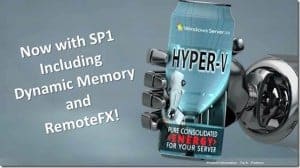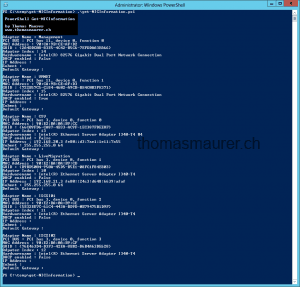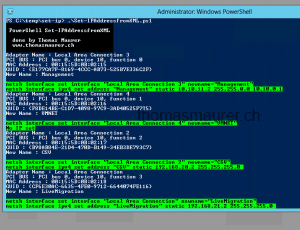If you are working a lot with Hyper-V and Hyper-V Clustering you know that something that takes a lot of time is configure the Hyper-V Host Network Adapters. First because most of the time you have a lot of NICs build into your host for the different Hyper-V and Cluster networks and secondly Windows names the NICs in a random way and this makes it hard to find out which network card is the right one. Maybe your first NIC on your Hyper-V Host01 is called “Local Area Connection 2” and on your second Hyper-V Host with the same hardware configuration the “same” NIC is called “Local Area Connection 3”. One of the possibilities to find out which network card is the right one is to check the MAC address of the network adapter. But for this you still have to know which MAC address is on which network adapter port.
Another way to do it is to plug in the network cables one by one. So you can see which port is active and then you can rename the network adapter. Now some times this one is one of the only solutions, but it takes a lot of time to do this on every host. And if you build Clusters up to 16 Hosts you really don’t want to do that.
Now there is a solution, you can sort your NICs by PCI bus and PCI slot. Maarten Wijsman did a blog post how you can do this on the Hyper-V.nu blog. With this knowledge you can start to automate this very easy.
I have created two Windows PowerShell scripts which make my life a lot easier.
First I configured the first Hyper-V host and renamed all the Network adapters. If you have a GUI server you could do that via GUI or if you have a Windows Server Core or Hyper-V Server you can do this via netsh.
netsh interface set interface "Local Area Connection 2" newname="Management"
If I have done that I use my Windows PowerShell script called Get-NICInformation.ps1 to get the information about the network adapters.
This gives me a lot of information about the NICs in my first hosts. But the important part is the order of the NICs. In my example I know that the order is this:
- Management
- VMNet
- CSV
- LiveMigration
- iSCSI01
- iSCSI02
Since my other hosts have the same hardware they will have the same PCI Bus order.
# ---------------------------------------------------------------------------------------------- # # Powershell Get-NICInformation $Rev: 748 $ # (c) 2011 Thomas Maurer. All rights reserved. # created by Thomas Maurer # www.thomasmaurer.ch # www.itnetx.ch # last Update by $Author: tmaurer $ on $Date: 2012-02-24 14:07:36 +0100 (Fr, 24 Feb 2012) $ # ---------------------------------------------------------------------------------------------- # #region [INFO BLOCK] # INFO Write-Host " " -BackgroundColor Black -ForegroundColor White Write-Host " PowerShell Get-NICInformation " -BackgroundColor Black -ForegroundColor White Write-Host " " -BackgroundColor Black -ForegroundColor White Write-Host " by Thomas Maurer " -BackgroundColor Black -ForegroundColor White Write-Host " www.thomasmaurer.ch " -BackgroundColor Black -ForegroundColor White Write-Host " " -BackgroundColor Black -ForegroundColor White #endregion $adapters = Get-WMIObject Win32_PNPSignedDriver | Where-Object { $_.DeviceClass -eq “NET” -and $_.HardWareID -like “*PCI*” } | Sort-Object location foreach ($adapter in $adapters ) { $adapterName = Get-WMIObject Win32_NetworkAdapter | Where-Object { $_.PNPDeviceID -eq $adapter.DeviceID } $adapterConfiguration = Get-WmiObject Win32_NetworkAdapterConfiguration | Where-Object { $_.index -eq $adapterName.Index } Write-Host ‘Adapter Name :’ $adapterName.NetConnectionID Write-Host ‘PCI BUS :’ $adapter.Location Write-Host ‘MAC Address :’ $adapterName.MACAddress Write-Host ‘GUID :’ $adapterName.GUID Write-Host ‘Adpater Index :’ $adapterName.Index Write-Host ‘Hardwarename :’ $adapterName.Name Write-Host ‘DHCP enabled :’ $adapterConfiguration.DHCPEnabled Write-Host ‘IP Address :’ $adapterConfiguration.IPAddress Write-Host ‘Subent :’ $adapterConfiguration.IPSubnet Write-Host ‘Default Gateway :’ $adapterConfiguration.DefaultIPGateway Write-Host }
For the next step I go to my second host. There I have my other Windows PowerShell script (Set-IPAddressfromXML) and a XML file (networkconfig.xml).
I edit the networkconfig.xml file with the correct network information. Important here are the id=”” parameters. They are showing the order of the NICs so with Get-NICInformation I can see the Management interface is the first one, so it gets id=”1″, VMNET is the second one it gets id=”2″ and so on. You also set the correct IP Address information for the second host. Most of the time you just have to change the last number.
You can also set non static IP Addresses (DHCP), in my case I did this for the VMNET adapter which will be used by the Hyper-V Virtual Switch and does not need a IP address.
<!--?xml version="1.0" encoding="utf-8"?-->After you have done this, you can now simply run the Set-IPAddressfromXML script. This will use the Information from the networkconfig.xml file and will rename all network adapters and will set the correct IP addresses.
# ---------------------------------------------------------------------------------------------- # # Powershell Set-IPAddressfromXML $Rev: 748 $ # (c) 2011 Thomas Maurer. All rights reserved. # created by Thomas Maurer # www.thomasmaurer.ch # www.itnetx.ch # last Update by $Author: tmaurer $ on $Date: 2012-02-24 14:07:36 +0100 (Fr, 24 Feb 2012) $ # ---------------------------------------------------------------------------------------------- # #region [INFO BLOCK] # INFO Write-Host " " -BackgroundColor Black -ForegroundColor White Write-Host " PowerShell Set-IPAddressfromXML " -BackgroundColor Black -ForegroundColor White Write-Host " " -BackgroundColor Black -ForegroundColor White Write-Host " done by Thomas Maurer " -BackgroundColor Black -ForegroundColor White Write-Host " www.thomasmaurer.ch " -BackgroundColor Black -ForegroundColor White Write-Host " " -BackgroundColor Black -ForegroundColor White #endregion #region [CONFIG BLOCK] # Get XML Information <pre lang="xml">$global:xmlData = Get-Content ".\networkconfig.xml" # Set NIC number starting value [int]$global:nicNumber = "1" #endregion #region [MAIN BLOCK] #Get NIC list $Adapters = Get-WMIObject Win32_PNPSignedDriver | where { $_.DeviceClass -eq “NET” -and $_.HardWareID -like “*PCI*”} | Sort-Object location foreach ($Adapter in $Adapters ) { # Get Adapter Info $AdapterName = Get-WMIObject Win32_NetworkAdapter | where { $_.PNPDeviceID -eq $Adapter.DeviceID } $nic = $xmlData.config.networkadapters.nic | Where-Object {$_.id -eq $nicNumber} # Write NIC Info Write-Host ‘Adapter Name :’ $AdapterName.NetConnectionID Write-Host ‘PCI BUS :’ $Adapter.Location Write-Host ‘MAC Address :’ $AdapterName.MACAddress Write-Host ‘GUID :’ $AdapterName.GUID Write-Host ‘New Name :’$nic.name Write-Host # Change NIC Name Invoke-Expression ('netsh interface set interface `"' + $AdapterName.NetConnectionID + '`" newname=`"' + $nic.name + '`" | out-null') Write-Host ('netsh interface set interface "' + $AdapterName.NetConnectionID + '" newname="' + $nic.name + '"') -BackgroundColor Green -ForegroundColor Black # if true set IP Address if ($nic.static -eq "true"){ Invoke-Expression ('netsh interface ipv4 set address `"' + $nic.name + '`" static ' + $nic.ip +' ' + $nic.subnet + ' ' + $nic.gateway + ' | out-null') Write-Host ('netsh interface ipv4 set address "' + $nic.name + '" static ' + $nic.ip +' ' + $nic.subnet + ' ' + $nic.gateway) -BackgroundColor Green -ForegroundColor Black } else { Write-Host "No IP set" -BackgroundColor Green -ForegroundColor Black } # Count +1 for next Adapter $nicNumber++ } #endregion
I can now copy the Set-IPAddressfromXML.ps1 and the networkconfig.xml to each Hyper-V hosts and edit the IP Addresses in the xml file, run the PowerShell file and I am done.
Lets recap:
- Rename the NICs of the first hosts
- Run the Get-NICInformation.ps1 on the first host and check the NIC order
- Edit the networkconfig.xml on the second hosts with the right order of the NICs
- Run the Set-IPAddressfromXML.ps1
- Do this for all Hyper-V Hosts.
I hope this will make life easier :)
You can download the Scripts from my Skydrive
Some other things:
- I have tested this with Windows Server 2008 R2, Hyper-V Server R2, Windows Server 8 beta, Hyper-V Server 8 beta
- It works for both because it’s not done with PowerShell v3, maybe I will update it to get it even better.
- I do not support this script, and you are running it on your own risk.
















Hi Thomas,
Great idea to create such a script, nice work!
One (little this time) comment though. If this script would be part of a larger deployment script, you may want to monitor the output which is provided… for example with SCOM or something like that. However, most of those monitoring tools can’t do anything with output provided by Write-Host :-( A simple alternative for this is to use Write-Output instead :-) And when you go a bit further in the output handling, also take a look at Write-Verbose :-)
Nice job on the code though :-D
Jeff.
right, have to do this next time, at the moment it is just a quick an dirty script.
does not work in windows 2012 powershell 3